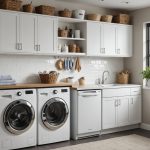Understanding Your Home Office Cooling Needs
Understanding the portable air conditioner needs of your home office is essential, especially as UK summer temperatures rise. During the hottest months, UK average temperatures can range between 23°C to 27°C. However, humidity also plays a significant role, often making rooms feel warmer. Accurately assessing these climate conditions will help to determine your specific cooling requirements.
When evaluating your home office cooling needs, consider the size and insulation of your workspace. Larger spaces or those situated in loft areas with poor insulation might need a unit with higher cooling capacity. Conversely, well-insulated or smaller rooms could manage with a less powerful device. Factors like the direction your windows face also influence the cooling load.
Additional reading : Top thermoses to elevate your outdoor and office experiences
Energy efficiency and operational costs are significant considerations. High energy efficiency ratings ensure effective cooling with reduced energy bills, making them crucial for a cost-effective setup. It’s worthwhile to balance initial investment against ongoing running costs, ensuring your portable air conditioner aligns with summer requirements while being financially sustainable.
By comprehensively understanding these aspects, you can better equip your home office with a comfortable climate, enabling productivity all summer long.
In the same genre : Enhancing Natural Light: Ideal Colors and Textures for Your UK Home”s Compact Foyer
Key Features to Look for in Portable Air Conditioners
Choosing the right portable air conditioner features can significantly impact your comfort and energy efficiency. One crucial factor to consider is the cooling capacity, typically measured in BTUs (British Thermal Units). Understanding BTU ratings helps you match the unit to your room size; for instance, a higher BTU is necessary for larger spaces to ensure effective cooling.
Energy efficiency is another essential aspect, measured by EER (Energy Efficiency Ratio) and SEER (Seasonal Energy Efficiency Ratio). These ratings indicate how well a unit converts energy into cooling. Opting for models with higher EER and SEER ratings can result in lower electricity bills.
Additionally, consider convenience features such as a remote control and programmable settings. These allow easy adjustments, enhancing usability. Furthermore, many portable air conditioners include dehumidification modes, which are invaluable in the humid summer months, providing a more comfortable indoor environment.
Lastly, assess the adaptability of the air conditioner to specific home office climate needs. Features enhancing usability, such as adjustable louvers and multiple fan speeds, can further customise your cooling experience, optimising it for various conditions and preferences.
Noise Levels and Operational Considerations
When selecting an air conditioner for your home office, noise levels can significantly influence work environment comfort. Understanding decibel ratings is vital, as excessive noise can disrupt concentration. Quieter models, typically operating at around 50 to 60 decibels, are preferable for productivity. Compare this to a regular conversation, which usually measures around 60 decibels.
UK regulations offer guidance on acceptable noise levels in office spaces, ensuring worker well-being. This aspect is crucial when choosing an air conditioner for a focused setting, where a noisy unit might be counterproductive. A model with adjustable fan settings can allow you to control the noise it produces, adapting it to quieter environments as needed.
Operational features, such as sleep mode, are also worth considering. This feature gradually reduces fan speed as you reach your desired temperature, lowering noise levels and saving energy. Choosing a portable air conditioner that balances effective cooling with minimal noise ensures not only comfort but also a conducive work atmosphere for home offices, adhering to both productivity and UK regulations.
Budgeting Your Portable Air Conditioner Purchase
Purchasing a portable air conditioner involves understanding both the initial costs and potential long-term savings. While it might be tempting to opt for the cheapest unit upfront, considering long-term energy savings is crucial for financial sustainability. Models with higher energy efficiency ratings may have a higher price tag but often result in lower energy bills over time, making them a wise investment.
In the UK market, cost considerations vary widely, with prices dependent on features, brand, and cooling capacity. Even within the same brand, units can range from budget to premium, offering various levels of cooling capabilities and convenience features. It is beneficial to compare models within your budget and assess their cost-effectiveness.
Understanding maintenance and repair costs is essential for budgeting. Regular maintenance, including filter changes and periodic servicing, can prevent costly repairs and prolong the unit’s lifespan. Choose models with readily available parts and service centres to facilitate easier, less costly maintenance.
- Initial vs Long-Term Costs: Balance initial expenses with expected savings.
- Price Range Considerations: Explore options across different price points.
- Maintenance Costs: Factor in ongoing care and repair expenses.
Installation Tips for Home Office Setups
Efficient portable air conditioner installation ensures optimal cooling in your home office. Proper unit placement is crucial; position the air conditioner near a window for efficient venting and fresh air intake. Ensure the exhaust hose is straight and short to maximise effectiveness in venting hot air out.
To enhance cooling efficiency, consider the direction of airflow. Position the unit to direct the cool air towards your workspace, and adjust the louvers as necessary. Ventilating windows with effective ducting optimizes air exchange, crucial in maintaining a cooler environment.
Home office setups present unique challenges like limited space or obstructed outlets. Use extension cords with caution to avoid overheating and adhere closely to manufacturer guidelines for distance and airflow. Installing draft stoppers in windows can minimise heat entry, keeping your office cooler.
Consider additional insulation around the window exhaust to prevent warm air from leaking back into the room. By addressing these elements, you can maximise the efficacy of your portable air conditioner, creating a comfortable and productive workspace tailored to your home office climate needs.
Maintenance and Care for Longevity
To prolong the lifespan and enhance the efficiency of your portable air conditioner, regular maintenance is crucial. Consistent unit care involves various tasks to ensure optimal performance. Start by focusing on filter replacement; it’s essential to replace or clean the filters according to the manufacturer’s recommendations, often monthly or bi-monthly. This prevents dust build-up, safeguarding the internal components and ensuring clean airflow.
Equally important is keeping the portable air conditioner clean. Wipe down the unit and inspect it for any accumulated dirt or grime that could obstruct airflow or promote bacterial growth. Paying attention to such details can significantly affect the unit care process.
Consider seasonal preparation as part of your routine maintenance. Before the cooling season begins, inspect the exhaust hose for blockages and ensure all components work efficiently. This proactive approach will provide a smooth start when the summer requirements demand peak performance from your device.
Maintenance tasks also include checking for any leaks or unusual noises, which might signal the need for professional service. These actions contribute to the longevity of your air conditioner, ensuring it runs smoothly through the UK summer and beyond.
Customer Reviews and Recommendations
Acquiring a portable air conditioner is a significant investment, making customer feedback and expert recommendations invaluable. Notably, many UK customers have expressed satisfaction with models offering energy efficiency coupled with robust cooling capacity, enhancing both usability and long-term value. One highlight in reviews is the reliability of brands known for swift customer service and comprehensive support, traits often praised in feedback sections.
When considering a purchase, expert recommendations emphasise models that balance performance with operability. Highly-rated air conditioners typically boast features like low noise levels and intuitive remote controls, enabling convenience and productivity. Reviews consistently advocate for units that effectively handle the UK summer requirements, offering cooling adaptability suited for diverse home office climates.
For informed decision-making, consider resources that provide detailed portable air conditioner reviews. Trusted outlets often offer insightful analyses on design, efficiency, and ease of use, providing a well-rounded view of each unit’s strengths and weaknesses. Paying attention to established experts and reputable review platforms will ensure a portable air conditioner meets both cooling expectations and budgetary constraints.











